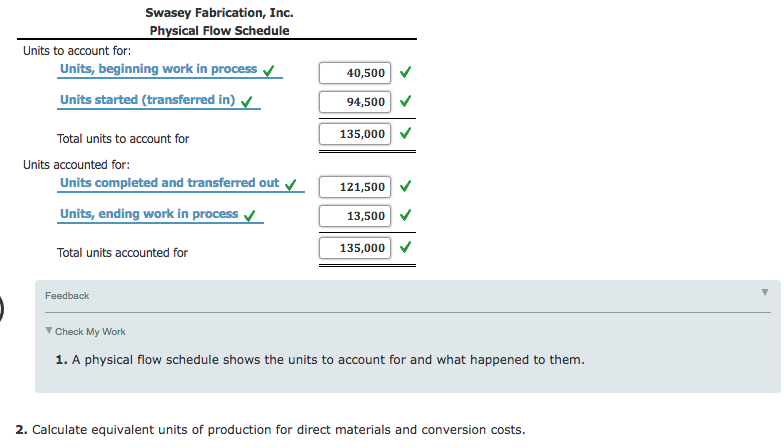
This is always the case when there are beginning WIP equivalent units. If there are no beginning WIP units, the two methods operate in exactly the same way. Again, the only difference between the two methods is that stinking beginning WIP. In short, these are common examples where 100% of direct materials how to view previous turbo tax files are added at the beginning of the process. Thus it would be appropriate for process costing to reflect 100% of direct material cost being incurred at the beginning of the process. In Chapter 4, I made a parenthetical comment about dividing overhead evenly between individual product units.
Cost per Equivalent Unit Calculation
Navarro started the month of June with 300,000 tons of iron ore in process in the Melting Department. During June, an additional 600,000 tons were introduced into the melting vats. In our next section, we will do a comparison and reconciliation of the same number of products through one process with each of the two methods. The articles and research support materials available on this site are educational and are not intended to be investment or tax advice. All such information is provided solely for convenience purposes only and all users thereof should be guided accordingly.
Income Statement
A similar process is used to account for the costs completed and transferred. Reconciling the number of units and the costs is part of the process costing system. The reconciliation involves the total of beginning inventory and units started into production. Units completed and transferred arefinished units and will always be 100% complete for equivalent unitcalculations for direct materials, direct labor and overhead.
- To begin, one needs to identify the total units that are to be considered, no matter their stage of completion at the beginning and end of the month.
- So when these firms allocate overhead, they also allocate direct materials and direct labor, i.e. all product costs.
- When goods are produced in a continuous process, how are costs to be allocated between work in process and finished goods?
- If these defects are non recurring then such units should be excluded from equivalent production.
- I explained, above, FIFO’s Step #3 using what’s called the subtractive method.
- So the cost of beginning WIP, the first-in and first-out portion of the units completed and transferred out is reflected below.
4.1 Weighted Average Rates (STEP #
One thing to keep in mind when using the weighted average method, we don’t need to compute the equivalent units for the ones transferred out. Those are considered 100% complete for the work done in that department, otherwise they wouldn’t be moving forward to the next process. Equivalent Units of Production is a more accurate method to determine whether the proposed output of the process will be able to meet or exceed that budgeted for. It allows us to accurately calculate if we are meeting our production.

It just doesn’t make sense to track how many milliseconds each worker spends on each product unit among a sea of identical product units moving down an assembly line. Now you can determine the cost of the units transferred out and the cost of the units still in process in the shaping department. Once the equivalent units for materials and conversion are known, the cost per equivalent unit is computed in a similar manner as the units accounted for.
Which of these is most important for your financial advisor to have?
All of the materials have been added to the shaping department, but all of the conversion elements have not; the numbers of equivalent units for material costs and for conversion costs remaining in ending inventory are different. All of the units transferred to the next department must be 100% complete with regard to that department’s cost or they would not be transferred. So the number of units transferred is the same for material units and for conversion units. The process cost system must calculate the equivalent units of production for units completed (with respect to materials and conversion) and for ending work in process with respect to materials and conversion.
To solve the problem of work-in-progress, we can calculate equivalent units of production (or “effective production”). The output of a department is always stated in terms of equivalent units of production. Since we are using FIFO method, we first include the entire beginning WIP in the cost of units transferred out and then include units started/added during the period. Thus, the 650,000 units that were completed are counted as 650,000 equivalent units of output no matter their physical origin from beginning inventory or otherwise.
Specifically, direct material costs are rarely incurred at the same time as labor and overhead costs. First, product costs (meaning direct materials, direct labor, and overhead). Process costing firms usually find it inefficient to trace any costs to individual product units, including costs that are traditionally considered direct materials or direct labor.
Although each department tracks the direct material it uses in its own department, all material is held in the material storeroom. Total costs to account for should always equal what was assigned in total costs accounted for. The table below summarizes the movement of physical units during the accounting period. Using the same example from the weighted average method, let’s use the following facts. In the next page, we will do a demonstration problem of the FIFO method for process costing. The units that remain in the ending work-in-process inventory, however, are not complete.

Leave a comment